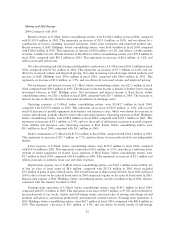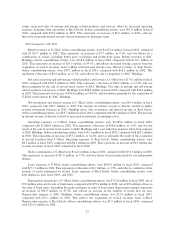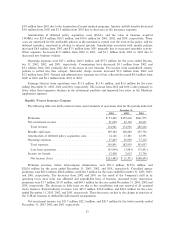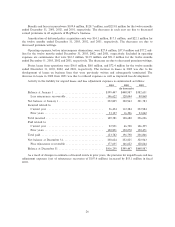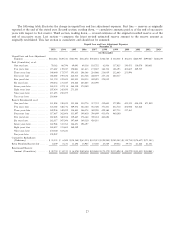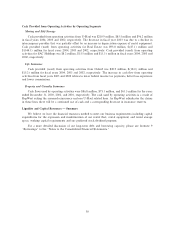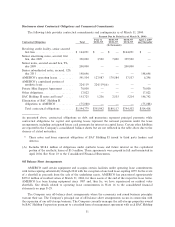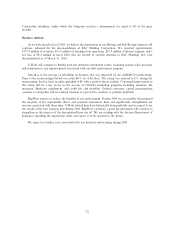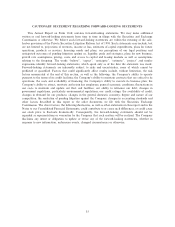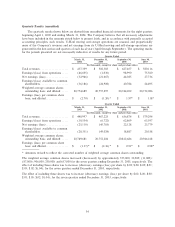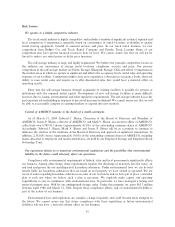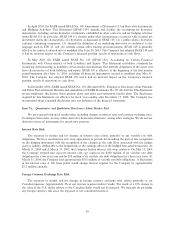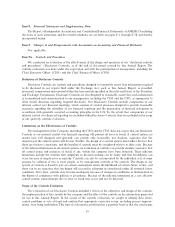U-Haul 2004 Annual Report Download - page 34
Download and view the complete annual report
Please find page 34 of the 2004 U-Haul annual report below. You can navigate through the pages in the report by either clicking on the pages listed below, or by using the keyword search tool below to find specific information within the annual report.Öeet expansion requirements from leasing and from the proceeds from the sale of trucks. We intend to focus
our growth on expanding our independent dealer network, which does not require a substantial amount of
capital resources.
Real Estate has traditionally Ñnanced the acquisition of self-storage properties to support U-Haul's
growth through lease and debt Ñnancing. U-Hauls's growth plan in self-storage is focused on eMove, which
does not require acquisition or construction of self-storage properties by the company. Therefore, Real Estate
will not require substantial capital for its future plans and our loan covenants give us the necessary Öexibility to
implement this plan.
SAC Holdings operations are funded by various mortgage loans and unsecured notes. SAC Holdings does
not utilize revolving lines of credit to Ñnance its operations or acquisitions. Certain of SAC Holdings loan
agreements contain restrictive covenants and restrictions on incurring additional subsidiary indebtedness.
Life Insurance
As of December 31, 2003, Oxford had no notes and loans payable in less than one year and its accounts
payable and accrued expenses total approximately $5.5 million. Oxford's Ñnancial assets (cash, receivables,
inventories, short-term investments, other investments and Ñxed maturities) at December 31, 2003 were
approximately $846.6 million. State insurance regulations restrict the amount of dividends that can be paid to
stockholders of insurance companies. As a result, Oxford's funds are generally not available to satisfy the
claims of AMERCO or its legal subsidiaries.
The primary sources of cash for Oxford include premiums, receipts for interest sensitive products and
investment income. The primary uses of cash are operating costs and beneÑt payments to policy holders.
Matching the investment portfolio to the cash Öow demands of the types of insurance being written is an
important consideration. BeneÑt and claim statistics are continually monitored to provide projections of future
cash requirements.
In addition to cash Öows from operating and Ñnancing activities, a substantial amount of liquid funds are
available through Oxford's short-term portfolio. Short-term investments amounted to $122.9 million,
$81.4 million and $53.5 million at December 31, 2003, 2002 and 2001, respectively.
Property and Casualty Insurance
As of December 31, 2003, RepWest had no notes or loans due in less than one year and its accounts
payable, accrued expenses, and other payables were approximately $18.4 million. RepWest's Ñnancial assets
(cash, receivables, inventories, short-term investments and Ñxed maturities) at December 31, 2003 were
approximately $353.2 million.
State insurance regulations restrict the amount of dividends that can be paid to stockholders of insurance
companies. As a result, RepWest's funds are generally not available to satisfy the claims of AMERCO or its
legal subsidiaries. Conversely, AMERCO's loan agreements prohibit any further loans, capital contributions
or other advances to RepWest by AMERCO.
The primary sources of cash for RepWest include premiums and investment income. The primary uses of
cash are operating costs and beneÑt payments to policy holders. Matching the investment portfolio to the cash
Öow demands of the types of insurance written is an important consideration. BeneÑt and claim statistics are
continually monitored to provide projections of future cash requirements.
RepWest's cash and cash equivalents and short-term investment portfolio were $62.1 million, $35.1 mil-
lion, and $18.3 million at December 31, 2003, 2002, and 2001, respectively. This balance reÖects funds in
transition from maturity proceeds to long term investments. This level of liquid assets, combined with
budgeted cash Öow, is adequate to meet periodic needs. Capital and operating budgets allow Republic to
schedule cash needs in accordance with investment and underwriting proceeds.
29





